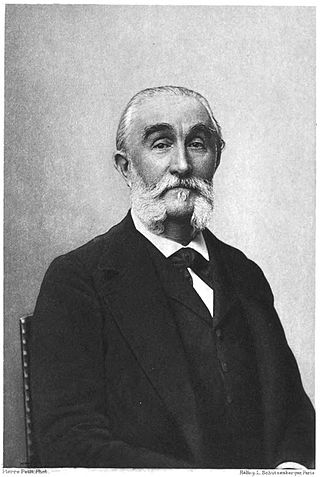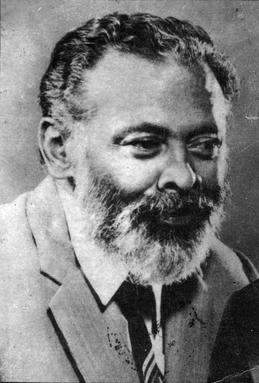
Jean-Joseph Rabearivelo, born Joseph-Casimir Rabearivelo, was a Malagasy poet who is widely considered to be Africa's first modern poet and the greatest literary artist of Madagascar. Part of the first generation raised under French colonization, Rabearivelo grew up impoverished and failed to complete secondary education. His passion for French literature and traditional Malagasy poetry (hainteny) prompted him to read extensively and educate himself on a variety of subjects, including the French language and its poetic and prose traditions. He published his first poems as an adolescent in local literary reviews, soon obtaining employment at a publishing house where he worked as a proofreader and editor of its literary journals. He published numerous poetry anthologies in French and Malagasy as well as literary critiques, an opera, and two novels.

Joseph Marie Henry Alfred Perrier de la Bâthie was a French botanist who specialized in the plants of Madagascar.

Alfred Grandidier was a French naturalist and explorer.
Louis-Guillaume Le Monnier was a French natural scientist and contributor to the Encyclopédie ou Dictionnaire raisonné des sciences, des arts et des métiers.
Pierre Naville was a French Surrealist writer and sociologist. He was a prominent member of the "Investigating Sex" group of Surrealist thinkers.

Catharanthus roseus, commonly known as bright eyes, Cape periwinkle, graveyard plant, Madagascar periwinkle, old maid, pink periwinkle, rose periwinkle, is a perennial species of flowering plant in the family Apocynaceae. It is native and endemic to Madagascar, but grown elsewhere as an ornamental and medicinal plant. It is a source of the drugs vincristine and vinblastine, used to treat cancer. It was formerly included in the genus Vinca as Vinca rosea.

Jean Baptiste Christophore Fusée Aublet was a French pharmacist, botanist and one of the earliest botanical explorers in South America. He was one of the first botanists to study ethnobotany in the Neotropics.

Adansonia grandidieri is the biggest and most famous of Madagascar's six species of baobabs. It is sometimes known as Grandidier's baobab or the giant baobab. In French it is called Baobab malgache. The local name is renala or reniala. This tree is endemic to the island of Madagascar, where it is an endangered species threatened by the encroachment of agricultural land. This is the tree found at the Avenue of the Baobabs.

Didierea madagascariensis, commonly known as the octopus tree, is a species of Didiereaceae endemic to the spiny thickets of southwestern Madagascar. It was first described scientifically by the French botanist Henri Ernest Baillon in 1880 and is the type species of the genus Didierea.

Harry Howard Barton Allan was a New Zealand teacher, botanist, scientific administrator, and writer. Despite never receiving a formal education in botany, he became an eminent scientist, publishing over 100 scientific papers, three introductory handbooks on New Zealand plants, and completing the first volume of a flora in his lifetime.
Gontran Georges Henri Hamel (1883–1944) was a French phycologist.
Henri Lucien Jumelle was a French botanist.
René Viguier was a French botanist known for his investigations of plants within the family Araliaceae.

Jean Verdi Salomon Razakandraina (1913–1978), commonly known as Dox, was a Malagasy writer and poet considered one of the most important literary figures in the country's history. He is principally renowned for his poetry and plays, but was also a painter, wrote and performed musical compositions, and translated several major French and English language works into Malagasy. His works have formed part of the language arts curriculum in Madagascar at every grade level since the country regained independence in 1960.
Raymond Benoist was a French botanist and entomologist. He is known for his research involving the plant family Acanthaceae.

Reverend Richard Baron was an English missionary and botanist who worked and lived in Madagascar from 1872 to 1907.

Aframomum angustifolium, known as "wild cardamom" in English, is a species in the ginger family Zingiberaceae that grows in tropical Africa and in Madagascar.

Albert Rakoto Ratsimamanga was a Malagasy physician, biochemist and diplomat. Born into a disgraced royal family; Ratsimamanga trained as a doctor of exotic medicine in French Madagascar and France, where he pioneered modern nutraceuticals. Ratsimamanga returned to Madagascar and, with his wife, Suzanne Urverg-Ratsimamanga, in 1957, established the Malagasy Institute of Applied Research which specialised in herbal medicine.

Suzanne Urverg-Ratsimamanga was a French-Malagasy Ashkenazi Jewish physician and biochemist. She was married to Albert Rakoto Ratsimamanga, with whom she founded the Malagasy Institute of Applied Research.

Lucile Allorge is a Madagascar-born French botanist.














